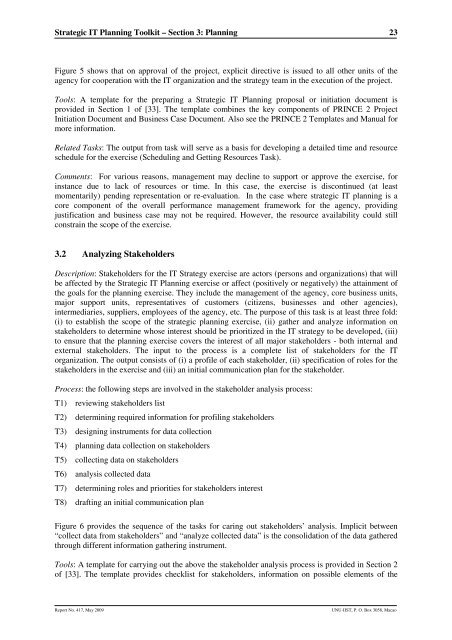Strategic IT Planning for Public Organizations: A Toolkit - UNU-IIST ...
Strategic IT Planning for Public Organizations: A Toolkit - UNU-IIST ...
Strategic IT Planning for Public Organizations: A Toolkit - UNU-IIST ...
Create successful ePaper yourself
Turn your PDF publications into a flip-book with our unique Google optimized e-Paper software.
<strong>Strategic</strong> <strong>IT</strong> <strong>Planning</strong> <strong>Toolkit</strong> – Section 3: <strong>Planning</strong><br />
23<br />
Figure 5 shows that on approval of the project, explicit directive is issued to all other units of the<br />
agency <strong>for</strong> cooperation with the <strong>IT</strong> organization and the strategy team in the execution of the project.<br />
Tools: A template <strong>for</strong> the preparing a <strong>Strategic</strong> <strong>IT</strong> <strong>Planning</strong> proposal or initiation document is<br />
provided in Section 1 of [33]. The template combines the key components of PRINCE 2 Project<br />
Initiation Document and Business Case Document. Also see the PRINCE 2 Templates and Manual <strong>for</strong><br />
more in<strong>for</strong>mation.<br />
Related Tasks: The output from task will serve as a basis <strong>for</strong> developing a detailed time and resource<br />
schedule <strong>for</strong> the exercise (Scheduling and Getting Resources Task).<br />
Comments: For various reasons, management may decline to support or approve the exercise, <strong>for</strong><br />
instance due to lack of resources or time. In this case, the exercise is discontinued (at least<br />
momentarily) pending representation or re-evaluation. In the case where strategic <strong>IT</strong> planning is a<br />
core component of the overall per<strong>for</strong>mance management framework <strong>for</strong> the agency, providing<br />
justification and business case may not be required. However, the resource availability could still<br />
constrain the scope of the exercise.<br />
3.2 Analyzing Stakeholders<br />
Description: Stakeholders <strong>for</strong> the <strong>IT</strong> Strategy exercise are actors (persons and organizations) that will<br />
be affected by the <strong>Strategic</strong> <strong>IT</strong> <strong>Planning</strong> exercise or affect (positively or negatively) the attainment of<br />
the goals <strong>for</strong> the planning exercise. They include the management of the agency, core business units,<br />
major support units, representatives of customers (citizens, businesses and other agencies),<br />
intermediaries, suppliers, employees of the agency, etc. The purpose of this task is at least three fold:<br />
(i) to establish the scope of the strategic planning exercise, (ii) gather and analyze in<strong>for</strong>mation on<br />
stakeholders to determine whose interest should be prioritized in the <strong>IT</strong> strategy to be developed, (iii)<br />
to ensure that the planning exercise covers the interest of all major stakeholders - both internal and<br />
external stakeholders. The input to the process is a complete list of stakeholders <strong>for</strong> the <strong>IT</strong><br />
organization. The output consists of (i) a profile of each stakeholder, (ii) specification of roles <strong>for</strong> the<br />
stakeholders in the exercise and (iii) an initial communication plan <strong>for</strong> the stakeholder.<br />
Process: the following steps are involved in the stakeholder analysis process:<br />
T1) reviewing stakeholders list<br />
T2) determining required in<strong>for</strong>mation <strong>for</strong> profiling stakeholders<br />
T3) designing instruments <strong>for</strong> data collection<br />
T4) planning data collection on stakeholders<br />
T5) collecting data on stakeholders<br />
T6) analysis collected data<br />
T7) determining roles and priorities <strong>for</strong> stakeholders interest<br />
T8) drafting an initial communication plan<br />
Figure 6 provides the sequence of the tasks <strong>for</strong> caring out stakeholders’ analysis. Implicit between<br />
“collect data from stakeholders” and “analyze collected data” is the consolidation of the data gathered<br />
through different in<strong>for</strong>mation gathering instrument.<br />
Tools: A template <strong>for</strong> carrying out the above the stakeholder analysis process is provided in Section 2<br />
of [33]. The template provides checklist <strong>for</strong> stakeholders, in<strong>for</strong>mation on possible elements of the<br />
Report No. 417, May 2009<br />
<strong>UNU</strong>-<strong>IIST</strong>, P. O. Box 3058, Macao

















